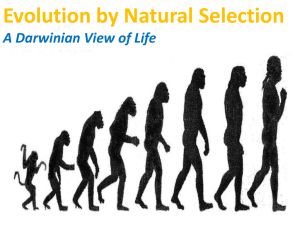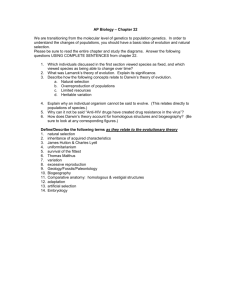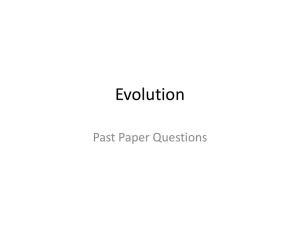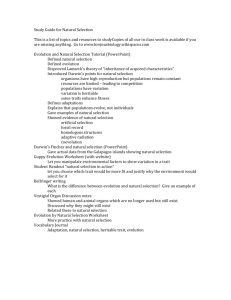Topic 5.4 Evolution - IBDPBiology-Dnl
advertisement
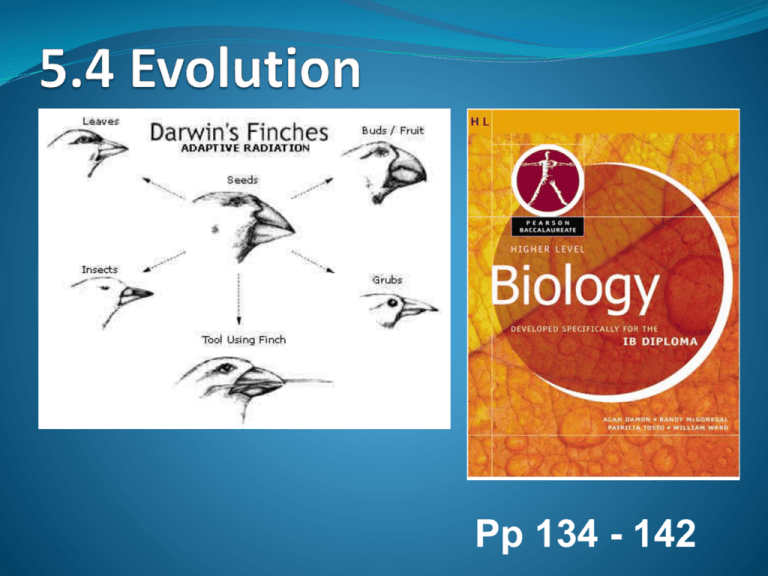
Pp 134 - 142 Define evolution. Evolution is the cumulative change in the heritable characteristics of a population over time. Not only does species evolve over time, but also new species can arise by evolution from pre-existing ones. Variation within a species is as result of different selection pressures operating in different parts of the world, yet this variation is not so vast to justify a construct such as race having a biological or scientific basis Evidence for Evolution It is difficult to prove that all organisms on Earth are as result of evolution, but there is a lot of evidence that supports the theory of evolution, including; fossil record, selective breeding of domesticated animals & homologous structures. Fossil Records fossils show changes in organisms over time fossilized organisms are different from those that are existing today, but they also share features with existing organisms (i.e. have homologous structures) suggest common ancestry; fossil show intermediate stages in evolution of groups i.e. there are missing link fossils Selective Breeding man has selectively breed animals and plants for thousands of years. the breeds of animal that are reared for human use are clearly related to wild species & in many cases domesticated animals can still interbreed with their wild relative domesticated breeds have been developed by selecting desirable traits, and breeding from them the striking differences in the heritable characteristics of domesticated breeds provides evidence that species can evolve rapidly Homologous Structures Homologous structures are structures that have developed from a common ancestor , sharing same fundamental plan but performing different functions The pentadactyl limb is an example of a homologous structure found in groups of organisms. the forelimbs of all tetrapods (such as amphibians, reptiles, birds, mammals) have the same basic pattern of 5 metacarpals and 5 phalanges arising from the same embryological structures because development is determined by many shared genes from a common a ancestor in each case the bones are modified and adapted to the function of the limb such as digging, swimming, flying, grasping etc. Populations tend to over-produce Many species often produce more offspring than can be supported by the environment in which they live i.e. more than the carrying capacity For example, female frogs lay hundreds of eggs but only a handful survive to adulthood and plants often produce hundreds more seeds than necessary to propagate the species. Consequence of the potential overproduction of offspring The population produces more offspring than the carrying capacity of the environment can support Overproduction results in struggle for existence i.e. offspring compete for limited resources (intraspecific competition) Some individuals have characteristic (or combination ) that give them a competitive advantage. These individuals are consequently 'fitter' in terms of freedom from disease, food availability etc. These individuals are more likely to successfully reproduce (offspring survive) Through inheritance of the genes for these advantageous characteristics the frequency of these characteristics become greater in the next generation. Members of a species show variation Populations of a species show variation i.e. differences in phenotypes Variation maybe discontinuous e.g. blood groups or continuous e.g. skin colour Discontinuous variation usually indicates the condition is controlled by one to two genes while Continuous variation normally indicates a polygenic condition or multiple alleles How sexual reproduction promotes variation in a species. segregation of alleles during meiosis crossing over in prophase I of meiosis random orientation i.e. assortment of homologues at metaphase I fertilization by chance, one of many male gametes fertile the ovum Large number of possible different gametes is 2n (223) genes (alleles) combining from two parents How natural selection leads to Theory of evolution by natural evolution selection originally advanced by Darwin & Wallace based on observations that overproduction of offspring leads to struggle for survival variation exists within the population some varieties are better adapted than others best adapted individuals survive, reproduce and pass on their characteristics (genes)to the next generation i.e. they are “selected for” with time, advantageous variants become more frequent in the population evolution is change in species (allele frequency) with time evidence that species have evolved include observed evolution such as multiple antibiotic resistance Examples of evolution in response to environmental change examples of evolution in response to environmental change includes: antibiotic resistance in bacteria melanism in peppered moth & ladybugs heavy metal tolerance in plants beak size in Darwin’s finches Antibiotic Resistance evolution is the process of cumulative change over time the theory of evolution in response to environmental change was proposed by Darwin & Wallace populations tend to grow exponentially more offspring than the environment can sustain are produced resulting in struggle for survival but the populations still remain constant over time individuals in populations show heritable variation due to mutations & sexual reproduction individuals in a population may have traits that are better suit them to the environment e.g. resistance to antibiotics in bacteria resistance to antibiotics in bacteria is heritable i.e. it can be passed from one generation to the next individuals with antibiotic resistance will survive when antibiotic is applied they will reproduce and leave more offspring with resistance to antibiotic the population will tend to accumulate the adaptation of antibiotic resistance therefore, the population will evolve with time Evolution of beak size in Darwin’s finches evolution is the process of cumulative change over time the theory of evolution in response to environmental change was proposed by Darwin & Wallace populations tend to grow exponentially more offspring than the environment can sustain are produced resulting in struggle for survival but the populations still remain constant over time individuals in populations show heritable variation due to mutations & sexual reproduction individuals in Darwin’s finches population show variation in beak size between weak long beaks & strong short beaks change in environment; weather dried up, nuts become more common than fruits individuals with short strong beaks got more food, survived & reproduced i.e. They had survival & reproductive advantage they reproduced & passed the genes for strong beaks to their offspring with time population will tend to more finches with short strong beaks therefore, the population will evolve with time Revision Questions Define evolution [1] Outline the evidences for evolution [6] Explain the consequence of the potential overproduction of offspring [3] Explain how sexual reproduction promotes variation in a species [6] Explain how natural selection leads to evolution [8] Giving 2 examples, explain how evolution occurs in response to environmental change [9]

